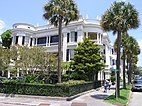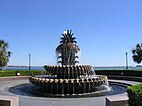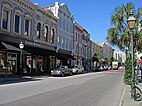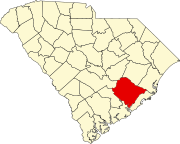Charleston, South Carolina
Charleston | ||
|---|---|---|
A house on the Battery Columbus Street Terminal – Port of Charleston King Street | ||
|
FIPS code 45-13330 | | |
| GNIS feature ID | 1221516[8] | |
| Website | www | |
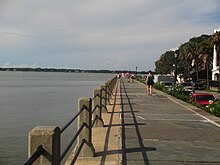
Charleston is the
Charleston was founded in 1670 as Charles Town, honoring
Charleston's significance in American history is tied to its role as a major slave trading port. Charleston slave traders like Joseph Wragg were the first to break through the monopoly of the Royal African Company and pioneered the large-scale slave trade of the 18th century; almost one-half of slaves imported to the United States arrived in Charleston.[11] In 2018, the city formally apologized for its role in the American slave trade.[12]
History

Colonial era (1670–1776)
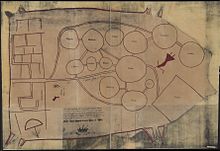
At the time of European colonization, the area was inhabited by the indigenous Cusabo, on whom the settlers declared war in October 1671. The settlers initially allied with the Westo, a northern indigenous tribe that traded in enslaved Indians. The settlers abandoned their alliance with the Westo in 1679 and allied with the Cusabo instead.[17]
The initial settlement quickly dwindled away and disappeared while another village—established by the settlers on Oyster Point at the confluence of the Ashley and Cooper rivers around 1672[15]—thrived. This second settlement formally replaced the original Charles Town in 1680.[18] (The original site is now commemorated as Charles Towne Landing.) The second location was more defensible and had access to a fine natural harbor. The new town had become the fifth largest in North America by 1690.[19]
A smallpox outbreak erupted in 1698, followed by an earthquake in February 1699. The latter caused a fire that destroyed about a third of the town. During rebuilding,[20] a yellow fever outbreak killed about 15% of the remaining inhabitants. Charles Town suffered between five and eight major yellow fever outbreaks over the first half of the 18th century.
It developed a reputation as one of the least healthy locations in the Thirteen Colonies for ethnic Europeans. Malaria was endemic. Although malaria did not have such high mortality as yellow fever, it caused much illness. It was a major health problem through most of the city's history before dying out in the 1950s after use of pesticides cut down on the mosquitoes that transmitted it.[21]

Charles Town was fortified according to a plan developed in 1704 under Governor Nathaniel Johnson. Both Spain and France contested Britain's claims to the region. Various bands of Native Americans and independent pirates also raided it.
On September 5–6, 1713 (O.S.) a violent
From the 1670s Charleston attracted pirates. The combination of a weak government and corruption made the city popular with pirates, who frequently visited and raided the city. Charles Town was besieged by the pirate Blackbeard for several days in May 1718. Blackbeard released his hostages and left in exchange for a chest of medicine from Governor Robert Johnson.[24]
Around 1719, the town's name began to be generally written as Charlestown[15] and, excepting those fronting the Cooper River, the old walls were largely removed over the next decade. Charlestown was a center for the inland colonization of South Carolina. It remained the southernmost point of the Southern Colonies until the Province of Georgia was established in 1732. As noted, the first settlers primarily came from Europe, Barbados and Bermuda. The Barbadian and Bermudan immigrants were planters who brought enslaved Africans with them, having purchased them in the West Indies.
Early immigrant groups to the city included the
By 1708, the majority of the colony's population were
In 1767 Gadsden's Wharf was constructed at the city port on the Cooper River; it ultimately extended 840 feet and was able to accommodate six ships at a time. Many slaves were sold from here.[28] Devoted to plantation agriculture that depended on enslaved labor, South Carolina became a slave society: it had a majority-Black population from the colonial period until after the Great Migration of the early 20th century, when many rural Blacks moved to northern and midwestern industrial cities to escape Jim Crow laws.
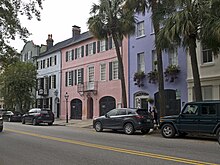
At the foundation of the town, the principal items of commerce were
peoples to secure the raw material.At the same time, Indians took each other as captives and slaves in warfare. From 1680 to 1720, approximately 40,000 native men, women, and children were sold through the port, principally to the
The area's unsuitability for growing
Throughout this period, the slaves were sold aboard the arriving ships or at ad hoc gatherings in the town's taverns.[32] Runaways and minor slave rebellions prompted the 1739 Security Act, which required all white men to carry weapons at all times (even to church on Sundays). Before it had fully taken effect, the Cato or Stono Rebellion broke out. The white community had recently been decimated by a malaria outbreak, and the rebels killed about 25 white people before being stopped by the colonial militia. As a result of their fears of rebellion, whites killed a total of 35 to 50 Black people.[33][34]
The planters attributed the violence to recently imported Africans and agreed to a 10-year moratorium on slave importation through Charlestown. They relied for labor upon the slave communities they already held. The
By the mid-18th century, Charlestown was the hub of the Atlantic slave trade in the Southern Colonies. Even with the decade-long moratorium, its customs processed around 40% of the enslaved Africans brought to North America between 1700 and 1775,[32] and about half up until the end of the African trade.
The plantations and the economy based on them made this the wealthiest city in the Thirteen Colonies[36] and the largest in population south of Philadelphia. In 1770, the city had 11,000 inhabitants—half slaves—and was the 4th-largest port in the colonies, after Boston, New York City, and Philadelphia.
The elite began to use their wealth to encourage cultural and social development. America's first theater building was constructed here in 1736; it was later replaced by today's Dock Street Theater.
American Revolution (1776–1783)

Delegates for the Continental Congress were elected in 1774, and South Carolina declared its independence from Britain on the steps of the Exchange. Slavery was again an important factor in the city's role during the Revolutionary War. The British attacked the settlement three times,[18] assuming that the settlement had a large base of Loyalists who would rally to their cause once given some military support.[39] The loyalty of white Southerners towards the Crown had largely been forfeited, however, by British legal cases (such as the 1772 Somersett case which marked the prohibition of slavery in England and Wales, a significant milestone in the abolitionist struggle) and military tactics (such as Dunmore's Proclamation in 1775) that promised the emancipation of slaves owned by Patriot planters; these efforts did, however, unsurprisingly win the allegiance of thousands of Black Loyalists.
The
Making the capture of Charlestown their chief priority, the British sent
The British continued to hold Charlestown for over a year following
Antebellum era (1783–1861)
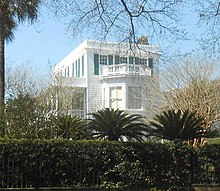
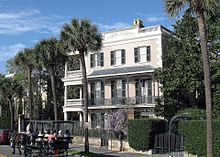

Between the Revolutionary War and the Civil War, Charleston experienced an economic boom, at least for the top strata of society. The expansion of cotton as a cash crop in the South both led to huge wealth for a small segment of society and funded impressive architecture and culture but also escalated the importance of slaves and led to greater and greater restrictions on Black Charlestonians.
By 1783, the growth of the city had reached a point where a municipal government became desirable; therefore on August 13, 1783, an act of incorporation for the city of Charleston was ratified. The act originally specified the city's name as "Charles Ton," as opposed to the previous Charlestown, but the spelling "Charleston" quickly came to dominate.[41]
Although Columbia had replaced it as the state capital in 1788, Charleston became even more prosperous as Eli Whitney's 1793 invention of the cotton gin sped the processing of the crop over 50 times. Britain's Industrial Revolution—initially built upon its textile industry—took up the extra production ravenously and cotton became Charleston's major export commodity in the 19th century.

The Bank of South Carolina, the second-oldest building in the nation to be constructed as a bank, was established in 1798; branches of the First and Second banks of the United States were also located in Charleston in 1800 and 1817.
Throughout the Antebellum Period, Charleston continued to be the only major American city with a majority-slave population.[42][d] The city's widespread use of slaves as workers was a frequent subject of writers and visitors: a merchant from Liverpool noted in 1834 that "almost all the working population are Negroes, all the servants, the carmen & porters, all the people who see at the stalls in Market, and most of the Journeymen in trades".[43] American traders had been prohibited from equipping the Atlantic slave trade in 1794 and all importation of slaves was banned in 1808, but American merchantmen frequently refused to permit British inspection for enslaved cargo, and smuggling remained common. Much more important was the domestic slave trade, which boomed as the Deep South developed into new cotton plantations. As a result of the trade, there was a forced migration of more than one million slaves from the Upper South to the Lower South in the antebellum years. During the early 19th century, the first dedicated slave markets were founded in Charleston, mostly near Chalmers and State streets.[32] Many domestic slavers used Charleston as a port in what was called the coastwise trade, traveling to such ports as Mobile and New Orleans.
Slave ownership was the primary marker of class and even the town's freedmen and free people of color typically kept slaves if they had the wealth to do so.[44] Visitors commonly remarked on the sheer number of Blacks in Charleston and their seeming freedom of movement,[45] though in fact—mindful of the Stono Rebellion and the slave revolution that established Haiti—the whites closely regulated the behavior of both slaves and free people of color. Wages and hiring practices were fixed, identifying badges were sometimes required, and even work songs were sometimes censored.[46] Punishment was handled out of sight by the city's workhouse, whose fees provided the municipal government with thousands a year.[47] In 1820, a state law mandated that each act of manumission (freeing a slave) required legislative approval, effectively halting the practice.[48]
The effects of slavery were pronounced on white society as well. The high cost of 19th-century slaves and their high rate of return combined to institute an oligarchic society controlled by about ninety interrelated families, where 4% of the free population controlled half of the wealth, and the lower half of the free population—unable to compete with owned or rented slaves—held no wealth at all.[42] The white middle class was minimal: Charlestonians generally disparaged hard work as the lot of slaves.[49] All the slaveholders taken together held 82% of the city's wealth and almost all non-slaveholders were poor.[42] Olmsted considered their civic elections "entirely contests of money and personal influence" and the oligarchs dominated civic planning:[51] the lack of public parks and amenities was noted, as was the abundance of private gardens in the wealthy's walled estates.[52]
In the 1810s, the town's churches intensified their discrimination against their Black parishioners, culminating in
In 1822, members of the church, led by
The registered
Charleston's embrace of classical architecture began after a devastating fire leveled much of the city. On April 27, 1838, Charleston suffered a catastrophic fire that burned more than 1000 buildings and caused about $3 million (equivalent to $84,910,000 in 2023) in damage at the time. The damaged buildings amounted to about one-fourth of all the businesses in the main part of the city. When the many homes and business were rebuilt or repaired, a great cultural awakening occurred. Previous to the fire, only a few homes were styled as Greek Revival; many residents decided to construct new buildings in that style after the conflagration. This tradition continued and made Charleston one of the foremost places to view
By 1840, the Market Hall and Sheds, where fresh meat and produce were brought daily, became a hub of commercial activity. The slave trade also depended on the port of Charleston, where ships could be unloaded and the slaves bought and sold. The legal importation of African slaves had ended in 1808, although smuggling was significant. However, the domestic trade was booming. More than one million slaves were transported from the Upper South to the Deep South in the antebellum years, as cotton plantations were widely developed through what became known as the Black Belt. Many slaves were transported in the coastwise slave trade, with slave ships stopping at ports such as Charleston.
Civil War (1861–1865)

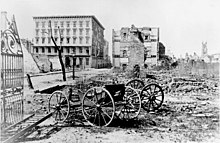
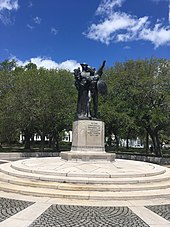
Charleston played a major part in the Civil War. As a pivotal city, both the Union and Confederate Armies vied for control of it. The Civil War began in Charleston Harbor in 1861, and ended mere months after the Union forces took control of Charleston in 1865.
Following
The first full battle of the
On December 11, 1861, an enormous fire burned over 500 acres (200 ha) of the city.
Union control of the sea permitted the repeated bombardment of the city, causing vast damage.[63] Although Admiral Du Pont's naval assault on the town's forts in April 1863 failed,[18] the Union navy's blockade shut down most commercial traffic. Over the course of the war, some blockade runners got through but not a single one made it into or out of the Charleston Harbor between August 1863 and March 1864.[63] The early submarine H.L. Hunley made a night attack on the USS Housatonic on February 17, 1864.[64]
General Gillmore's land assault in July 1864 was unsuccessful
Postbellum (1865–1945)
Reconstruction
After the defeat of the Confederacy, federal forces remained in Charleston during
By the late 1870s, industry was bringing the city and its inhabitants back to a renewed vitality; new jobs attracted new residents.
In 1875, blacks made up 57% of the city's and 73% of the county's population.
Violent incidents occurred throughout the Piedmont of the state as white insurgents struggled to maintain
Politics
In the early 20th century strong political machines emerged in the city reflecting economic, class, racial, and ethnic tensions. The factions nearly all opposed U.S. Senator Ben Tillman who repeatedly attacked and ridiculed the city in the name of upstate poor farmers. Well organized factions within the Democratic Party in Charleston gave the voters clear choices and played a large role in state politics.[70]
1886 earthquake
On August 31, 1886, Charleston experienced a strong
Charleston race riots
The Charleston race riot of 1919 took place on the night of Saturday, May 10, between members of the US Navy and the local black population. They attacked black individuals, businesses, and homes killing six and injuring dozens.
Contemporary era (1945–present)

Charleston languished economically for several decades in the 20th century, though the large federal military presence in the region helped to shore up the city's economy. Charleston's tourism boom began in earnest following the publication of Albert Simons and Samuel Lapham's Architecture of Charleston[71] in the 1920s.[72]
The Charleston Hospital Strike of 1969, in which mostly black workers protested discrimination and low wages, was one of the last major events of the civil rights movement. It attracted Ralph Abernathy, Coretta Scott King, Andrew Young, and other prominent figures to march with the local leader, Mary Moultrie.
Joseph P. Riley Jr. was elected mayor in the 1970s, and helped advance several cultural aspects of the city.
Between 1989 and 1996, Charleston saw two significant economic hits. First, the eye of Hurricane Hugo came ashore at Charleston Harbor in 1989, and though the worst damage was in nearby
After having been a majority-minority city for most of its history, in the late 20th century many whites began returning to the urban core of Charleston and the area gentrified with rising prices and rents. From 1980 to 2010, the peninsula's population shifted from two-thirds black to two-thirds white; in 2010 residents numbered 20,668 whites to 10,455 blacks.[75] Many African Americans moved to the less-expensive suburbs in these decades.[75]
On June 17, 2015, 21-year-old white supremacist Dylann Roof entered the historic Emanuel African Methodist Episcopal Church and sat in on part of a Bible study before shooting and killing nine people and injuring a tenth, all African Americans.[76] Senior pastor Clementa Pinckney, who also served as a state senator, was among those killed during the attack. The deceased also included congregation members Susie Jackson, 87; Rev. Daniel Simmons Sr., 74; Ethel Lance, 70; Myra Thompson, 59; Cynthia Hurd, 54; Rev. Depayne Middleton-Doctor, 49; Rev. Sharonda Coleman-Singleton, 45; and Tywanza Sanders, 26.[77] The attack garnered national attention, and sparked a debate on historical racism, Confederate symbolism in Southern states, and gun violence, in part based on Roof's online postings. A memorial service on the campus of the College of Charleston was attended by President Barack Obama, Michelle Obama, Vice President Joe Biden, Jill Biden, and Speaker of the House John Boehner.
Condemnation of role in the slave trade
On June 17, 2018, the Charleston City Council apologized for its role in the slave trade and condemned its "inhumane" history. It also acknowledged wrongs committed against African Americans by slavery and Jim Crow laws.[78]
Geography
The city proper consists of six distinct districts.
- Downtown, or sometimes referred to as "The Peninsula", is Charleston's center city separated by the Ashley River to the west and the Cooper River to the east
- West Ashley, residential area to the west of Downtown bordered by the Ashley River to the east and the Stono River to the west
- Johns Island, far western limits of Charleston, bordered by the Stono River to the east, Kiawah River to the south and Wadmalaw Island to the west
- James Island, popular residential area between Downtown and the town of Folly Beach with portions of the independent town of James Island intermixed
- Cainhoy Peninsula, far eastern limits of Charleston bordered by the Wando River to the west and Nowell Creek to the east
- Daniel Island, residential area to the north of downtown, east of the Cooper River and west of the Wando River
Topography

The incorporated city fitted into 4–5 sq mi (10–13 km2) as late as
Charleston Harbor runs about 7 mi (11 km) southeast to the Atlantic with an average width of about 2 mi (3.2 km), surrounded on all sides except its entrance. Sullivan's Island lies to the north of the entrance and Morris Island to the south. The entrance itself is about 1 mi (2 km) wide; it was originally only 18 ft (5 m) deep but began to be enlarged in the 1870s.[52] The tidal rivers (Wando, Cooper, Stono, and Ashley) are evidence of a submergent or drowned coastline. There is a submerged river delta off the mouth of the harbor, and the Cooper River is deep.
Climate

Charleston has a
Downtown Charleston's climate is somewhat milder than the airport's due to stronger maritime influence. This is especially true in the winter, with the average January low in downtown being 43.6 °F (6 °C) to the airport's 38.9 °F (4 °C) for example.
The highest temperature recorded within city limits was 104 °F (40 °C) on June 2, 1985, and June 24, 1944; the lowest was 7 °F (−14 °C) on
| Climate data for Charleston Int'l, South Carolina (1991–2020 normals,[82] extremes 1938–present) | |||||||||||||
|---|---|---|---|---|---|---|---|---|---|---|---|---|---|
| Month | Jan | Feb | Mar | Apr | May | Jun | Jul | Aug | Sep | Oct | Nov | Dec | Year |
| Record high °F (°C) | 83 (28) |
87 (31) |
90 (32) |
95 (35) |
101 (38) |
103 (39) |
104 (40) |
105 (41) |
99 (37) |
94 (34) |
88 (31) |
83 (28) |
105 (41) |
| Mean maximum °F (°C) | 76.7 (24.8) |
78.7 (25.9) |
84.2 (29.0) |
88.0 (31.1) |
93.0 (33.9) |
96.4 (35.8) |
97.7 (36.5) |
96.6 (35.9) |
92.9 (33.8) |
87.4 (30.8) |
82.2 (27.9) |
77.2 (25.1) |
98.9 (37.2) |
| Mean daily maximum °F (°C) | 60.2 (15.7) |
63.8 (17.7) |
70.1 (21.2) |
77.1 (25.1) |
83.6 (28.7) |
88.5 (31.4) |
91.3 (32.9) |
89.8 (32.1) |
85.4 (29.7) |
77.9 (25.5) |
69.4 (20.8) |
62.7 (17.1) |
76.6 (24.8) |
| Daily mean °F (°C) | 49.5 (9.7) |
52.7 (11.5) |
58.7 (14.8) |
65.8 (18.8) |
73.3 (22.9) |
79.4 (26.3) |
82.5 (28.1) |
81.4 (27.4) |
76.9 (24.9) |
67.8 (19.9) |
58.3 (14.6) |
52.2 (11.2) |
66.5 (19.2) |
| Mean daily minimum °F (°C) | 38.9 (3.8) |
41.6 (5.3) |
47.3 (8.5) |
54.5 (12.5) |
63.0 (17.2) |
70.4 (21.3) |
73.7 (23.2) |
73.1 (22.8) |
68.3 (20.2) |
57.7 (14.3) |
47.1 (8.4) |
41.6 (5.3) |
56.4 (13.6) |
| Mean minimum °F (°C) | 22.0 (−5.6) |
26.2 (−3.2) |
30.8 (−0.7) |
39.7 (4.3) |
50.2 (10.1) |
61.7 (16.5) |
68.2 (20.1) |
66.4 (19.1) |
57.0 (13.9) |
41.7 (5.4) |
31.7 (−0.2) |
26.0 (−3.3) |
20.3 (−6.5) |
| Record low °F (°C) | 6 (−14) |
12 (−11) |
15 (−9) |
29 (−2) |
36 (2) |
50 (10) |
58 (14) |
56 (13) |
42 (6) |
27 (−3) |
15 (−9) |
8 (−13) |
6 (−14) |
| Average precipitation inches (mm) | 3.37 (86) |
3.05 (77) |
3.35 (85) |
3.29 (84) |
3.32 (84) |
6.21 (158) |
6.60 (168) |
6.97 (177) |
6.01 (153) |
4.33 (110) |
2.66 (68) |
3.35 (85) |
52.51 (1,334) |
| Average snowfall inches (cm) | 0.2 (0.51) |
0.1 (0.25) |
0.0 (0.0) |
0.0 (0.0) |
0.0 (0.0) |
0.0 (0.0) |
0.0 (0.0) |
0.0 (0.0) |
0.0 (0.0) |
0.0 (0.0) |
0.0 (0.0) |
0.0 (0.0) |
0.3 (0.76) |
| Average precipitation days (≥ 0.01 in) | 8.9 | 8.5 | 8.2 | 7.9 | 8.1 | 12.1 | 13.2 | 13.1 | 10.2 | 7.3 | 6.9 | 9.3 | 113.7 |
| Average snowy days (≥ 0.1 in) | 0.1 | 0.1 | 0.0 | 0.0 | 0.0 | 0.0 | 0.0 | 0.0 | 0.0 | 0.0 | 0.0 | 0.0 | 0.2 |
| Average relative humidity (%)
|
69.8 | 67.4 | 68.1 | 67.5 | 72.5 | 75.1 | 76.6 | 78.9 | 78.2 | 74.1 | 72.7 | 71.6 | 72.7 |
| Average dew point °F (°C) | 36.0 (2.2) |
37.4 (3.0) |
44.8 (7.1) |
51.3 (10.7) |
61.0 (16.1) |
67.8 (19.9) |
71.4 (21.9) |
71.4 (21.9) |
66.9 (19.4) |
55.9 (13.3) |
47.5 (8.6) |
39.9 (4.4) |
54.3 (12.4) |
| Mean monthly sunshine hours | 179.3 | 186.7 | 243.9 | 275.1 | 294.8 | 279.5 | 287.8 | 256.7 | 219.7 | 224.5 | 189.5 | 171.3 | 2,808.8 |
| Percent possible sunshine | 56 | 61 | 66 | 71 | 69 | 65 | 66 | 62 | 59 | 64 | 60 | 55 | 63 |
| Average ultraviolet index | 2.4 | 3.6 | 5.4 | 7.3 | 8.5 | 9.3 | 9.5 | 8.6 | 6.9 | 4.7 | 2.9 | 2.2 | 5.9 |
| Source 1: NOAA (relative humidity and sun 1961–1990)[80][83][81] | |||||||||||||
| Source 2: UV Index Today (1995 to 2022)[84] | |||||||||||||
| Climate data for Charleston, South Carolina (Downtown), 1991–2020 normals,[82] extremes 1893–present | |||||||||||||
|---|---|---|---|---|---|---|---|---|---|---|---|---|---|
| Month | Jan | Feb | Mar | Apr | May | Jun | Jul | Aug | Sep | Oct | Nov | Dec | Year |
| Record high °F (°C) | 82 (28) |
83 (28) |
94 (34) |
94 (34) |
100 (38) |
104 (40) |
103 (39) |
103 (39) |
100 (38) |
95 (35) |
87 (31) |
81 (27) |
104 (40) |
| Mean maximum °F (°C) | 72.4 (22.4) |
74.8 (23.8) |
80.0 (26.7) |
83.8 (28.8) |
90.1 (32.3) |
93.4 (34.1) |
95.3 (35.2) |
93.9 (34.4) |
90.8 (32.7) |
85.2 (29.6) |
79.2 (26.2) |
74.3 (23.5) |
96.8 (36.0) |
| Mean daily maximum °F (°C) | 58.0 (14.4) |
60.3 (15.7) |
65.6 (18.7) |
72.3 (22.4) |
79.0 (26.1) |
84.3 (29.1) |
87.5 (30.8) |
86.4 (30.2) |
82.6 (28.1) |
75.6 (24.2) |
67.1 (19.5) |
60.9 (16.1) |
73.3 (22.9) |
| Daily mean °F (°C) | 50.8 (10.4) |
53.2 (11.8) |
58.8 (14.9) |
66.0 (18.9) |
73.5 (23.1) |
79.2 (26.2) |
82.3 (27.9) |
81.4 (27.4) |
77.6 (25.3) |
69.4 (20.8) |
60.1 (15.6) |
53.8 (12.1) |
67.2 (19.6) |
| Mean daily minimum °F (°C) | 43.6 (6.4) |
46.1 (7.8) |
52.0 (11.1) |
59.7 (15.4) |
68.0 (20.0) |
74.2 (23.4) |
77.1 (25.1) |
76.5 (24.7) |
72.5 (22.5) |
63.2 (17.3) |
53.1 (11.7) |
46.8 (8.2) |
61.1 (16.2) |
| Mean minimum °F (°C) | 28.6 (−1.9) |
32.3 (0.2) |
37.2 (2.9) |
46.1 (7.8) |
56.3 (13.5) |
67.1 (19.5) |
71.7 (22.1) |
70.8 (21.6) |
63.4 (17.4) |
48.6 (9.2) |
38.9 (3.8) |
33.1 (0.6) |
26.9 (−2.8) |
| Record low °F (°C) | 10 (−12) |
7 (−14) |
22 (−6) |
36 (2) |
45 (7) |
52 (11) |
61 (16) |
59 (15) |
50 (10) |
37 (3) |
17 (−8) |
12 (−11) |
7 (−14) |
| Average precipitation inches (mm) | 2.56 (65) |
2.56 (65) |
3.03 (77) |
2.96 (75) |
2.58 (66) |
4.85 (123) |
5.08 (129) |
6.11 (155) |
5.25 (133) |
4.07 (103) |
2.30 (58) |
2.91 (74) |
44.26 (1,124) |
| Average precipitation days (≥ 0.01 in) | 8.4 | 8.0 | 7.9 | 7.0 | 6.8 | 10.5 | 11.6 | 11.7 | 8.6 | 6.8 | 6.1 | 8.5 | 101.9 |
| Source: NOAA[80][85][86] | |||||||||||||
Metropolitan statistical area
As defined by the Office of Management and Budget, for use by the U.S. Census Bureau and other U.S. Government agencies for statistical purposes only, Charleston is included within the Charleston-North Charleston, SC Metropolitan Statistical Area, which consists of three counties: Charleston, Berkeley, and Dorchester. The metropolitan statistical area had an estimated population of 849,417 in 2023.[7] North Charleston is the second-largest city in the metro area and ranks as the third-largest city in the state; Mount Pleasant and Summerville are the next-largest cities.
The traditional parish system persisted until the
Demographics
| Year | Pop. | ±% |
|---|---|---|
| 1770 | 10,863 | — |
| 1790 | 16,359 | +50.6% |
| 1800 | 18,824 | +15.1% |
| 1810 | 24,711 | +31.3% |
| 1820 | 24,780 | +0.3% |
| 1830 | 30,289 | +22.2% |
| 1840 | 29,261 | −3.4% |
| 1850 | 42,985 | +46.9% |
| 1860 | 40,522 | −5.7% |
| 1870 | 48,956 | +20.8% |
| 1880 | 49,984 | +2.1% |
| 1890 | 54,955 | +9.9% |
| 1900 | 55,807 | +1.6% |
| 1910 | 58,833 | +5.4% |
| 1920 | 67,957 | +15.5% |
| 1930 | 62,265 | −8.4% |
| 1940 | 71,275 | +14.5% |
| 1950 | 70,174 | −1.5% |
| 1960 | 60,288 | −14.1% |
| 1970 | 66,945 | +11.0% |
| 1980 | 69,779 | +4.2% |
| 1990 | 80,414 | +15.2% |
| 2000 | 96,650 | +20.2% |
| 2010 | 120,083 | +24.2% |
| 2020 | 150,227 | +25.1% |
| 2023 | 155,369 | +3.4% |
| Source: U.S. Decennial Census[88][6] 1770 estimate[89] | ||
| Race | Num. | Perc. |
|---|---|---|
White (non-Hispanic)
|
108,766 | 71.5% |
Black or African American (non-Hispanic)
|
25,332 | 21.7% |
Native American
|
278 | 0.19% |
Asian
|
3,240 | 2.16% |
Pacific Islander
|
154 | 0.1% |
Other/Mixed
|
5,639 | 3.75% |
Latino
|
6,818 | 3.2% |
As of the 2020 census, there were 150,227 people, 58,902 households, and 31,780 families residing in the city.
Language
Given Charleston's high concentration of African Americans who spoke the Gullah language, a creole language that developed on the Sea Islands and in the Low Country, the local speech patterns were also influenced by this community. Today, Gullah is still spoken by many African American residents.[91] However, rapid development since 1980, especially on the surrounding Sea Islands, has attracted residents from outside the area and led to a decline in Gullah's prominence.
The traditional educated Charleston accent has long been noted in the state and throughout the South. It is typically heard in wealthy European American older people who trace their families back generations in the city. It has ingliding or monophthongal long mid-vowels, raises ay and aw in certain environments, and is
Religion
Charleston is known as "The Holy City".[1] Despite beliefs that the term dates to the city's earliest days and refers to its religiously tolerant culture, the term was coined in the 20th century, likely as a mockery of Charlestonians' self-satisfied attitude about their city.[93] Regardless of the nickname's origination, residents have embraced the term and explained it in more flattering terms.
The Anglican church was dominant in the colonial era, and the
South Carolina has long allowed
The city's oldest Catholic parish, St. Mary of the Annunciation Catholic Church, is the mother church of Catholicism in South Carolina, North Carolina, and Georgia. In 1820, Charleston was established as the see city of the Diocese of Charleston, which at the time comprised the Carolinas and Georgia, and presently encompasses the state of South Carolina.
The
Culture
Charleston's culture blends traditional Southern U.S., English, French, and West African elements. The downtown peninsula has a number of art, music, local cuisine, and fashion venues. Spoleto Festival USA, held annually in late spring, was founded in 1977 by Pulitzer Prize-winning composer Gian Carlo Menotti, who sought to establish a counterpart to the Festival dei Due Mondi (the Festival of Two Worlds) in Spoleto, Italy.
Charleston's oldest community theater group, the Footlight Players, has provided theatrical productions since 1931.[99] A variety of performing arts venues includes the historic Dock Street Theatre. The annual Charleston Fashion Week held each spring in Marion Square brings in designers, journalists, and clients from across the nation.[100] Charleston is known for its local seafood, which plays a key role in the city's renowned cuisine, comprising staple dishes such as gumbo, she-crab soup, fried oysters, Lowcountry boil, deviled crab cakes, red rice, and shrimp and grits. Rice is the staple in many dishes, reflecting the rice culture of the Low Country. The cuisine in Charleston is also strongly influenced by British and French elements.[101]
Annual cultural events and fairs
Charleston annually hosts Spoleto Festival USA founded by Gian Carlo Menotti, a 17-day art festival featuring over 100 performances by individual artists in a variety of disciplines.[102] The annual Piccolo Spoleto festival takes place at the same time and features local performers and artists, with hundreds of performances throughout the city. Other festivals and events include Historic Charleston Foundation's Festival of Houses and Gardens and Charleston Antiques Show,[103] the Taste of Charleston, The Lowcountry Oyster Festival, the Cooper River Bridge Run, The Charleston Marathon,[104] Southeastern Wildlife Exposition (SEWE),[105] Charleston Food and Wine Festival, Charleston Fashion Week, the MOJA Arts Festival, and the Holiday Festival of Lights (at James Island County Park), and the Charleston International Film Festival.[106] The Charleston Conference is a major library industry event, held in the city center since 1980.[107]
Music
The
The Jenkins Orphanage was established in 1891 by the Rev. Daniel J. Jenkins in Charleston. The orphanage accepted donations of musical instruments and Rev. Jenkins hired local Charleston musicians and Avery Institute Graduates to tutor the boys in music. As a result, Charleston musicians became proficient on a variety of instruments and were able to read music expertly.[109] These traits set Jenkins musicians apart and helped land some of them positions in big bands with Duke Ellington and Count Basie. William "Cat" Anderson, Jabbo Smith, and Freddie Green are but a few of the alumni who became professional musicians. Orphanages around the country began to develop brass bands in the wake of the Jenkins Orphanage Band's success.[110][111]
As many as five bands were on tour during the 1920s. The Jenkins Orphanage Band played in the inaugural parades of Presidents
To this day, Charleston is home to many musicians in all genres.[116]
Live theater
Charleston has a vibrant theater scene and is home to America's first theater. Most of the theaters are part of the League of Charleston Theatres, better known as Theatre Charleston.[117] Some of the city's theaters include:
- Dock Street Theatre, opened in the 1930s on the site of America's first purpose-built theater building, is home of the Charleston Stage Company, South Carolina's largest professional theater company.
- Queen Street Playhouse, a former cotton warehouse that was fully converted to a theater in 1986. It is the home of the Footlight Players, a Charleston theater troupe first organized in 1932.
- Sottile Theater, on the campus of the College of Charleston.
Museums, historical sites, and other attractions
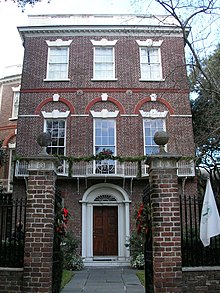

Charleston has many historic buildings, art and historical museums, public parks, and other attractions, including:
- Avery Research Center for African American History and Culture, established to collect, preserve, and make public the unique historical and cultural heritage of African Americans in Charleston and the South Carolina Low Country. Avery's archival collections, museum exhibitions, and public programming reflect these diverse populations, as well as the wider African Diaspora.
- The Battery, a historic defensive seawall and promenade located at the tip of the peninsula along with White Point Garden, a park featuring several memorials and Civil War-era artillery pieces.
- Calhoun Mansion, a 24,000-square-foot (2,200 m2), 1876 Victorian home at 16 Meeting Street, is named for a grandson of John C. Calhoun who lived there with his wife, the builder's daughter. The private house is periodically open for tours.
- Charleston Museum, America's first museum, founded in 1773.
- Exchange and Provost, built in 1767, it is operated as a museum by the Daughters of the American Revolution.
- Gibbes Museum of Art, opened in 1905, it houses principally American works with a Charleston or Southern connection.
- Gov. William Aiken House, also known as the Aiken-Rhett House, is a house museum built in 1820.
- Fireproof Building, houses the South Carolina Historical Society which has a rotating series of historical displays.
- Fort Sumter, site of the first shots fired in the Civil War, is located in Charleston Harbor. The National Park Service maintains a visitor center for Fort Sumter at Liberty Square (near the South Carolina Aquarium), and boat tours including the fort depart nearby.
- Halsey Institute of Contemporary Art at the College of Charleston, a free a non-collecting contemporary arts organization.[118]
- Heyward-Washington House, a historic house museum owned and operated by the Charleston Museum. Furnished for the late 18th century, the house includes a collection of Charleston-made furniture.
- International African American Museum, opened in 2023.
- Joseph Manigault House, a historic house museum owned and operated by the Charleston Museum. The house was designed by Gabriel Manigault and is significant for its Adam style architecture.
- Market Hall and Sheds, also known as the City Market or simply the Market, stretch several blocks behind 188 Meeting Street. Market Hall was built in the 1841 and houses the Daughters of the Confederacy Museum. The sheds house some permanent stores, but are mainly occupied by open-air vendors.
- Nathaniel Russell House, an important federal-style house open to the public as a house museum.
- Old Slave Mart Museum, located at 6 Chalmers Street in the historic district is the first African American Museum. It has operated since 1938.[119]
- Powder Magazine, a 1713 gunpowder magazine and museum. It is the oldest surviving public building in South Carolina.
- Rainbow Row, an iconic strip of homes along the harbor that date back to the mid-18th century. Though the homes are not open to the public, they are one of the most photographed attractions in the city and are featured heavily in local art.[120]
- South Carolina Aquarium, includes revolving exhibits while its permanent focus is on the aquatic life of South Carolina.
- Waterfront Park, located on the Cooper River.[121]
Sports
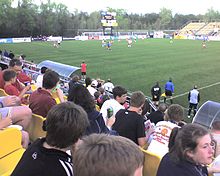
Charleston is home to a number of professional, minor league, and amateur sports teams:
- soccer team, play in the USL Championship. The Battery play at Patriots Point Soccer Complex.
- Charleston Gaelic Athletic Association, a Gaelic athletic club focusing on the sports of hurling and Gaelic football. The club competes in the Southeastern Division of the North American County Board of the GAA. The club hosts other division clubs in the Holy City Cup each spring.[122]
- Charleston Outlaws RFC, a rugby union club in the Palmetto Rugby Union, USA Rugby South, and USA Rugby. It competes in Men's Division II against the Cape Fear, Columbia, Greenville, and Charlotte "B" clubs. The club also hosts a rugby sevens tournament during Memorial Day weekend.
- Low-A East and are an affiliate of the Tampa Bay Rays.[123] The RiverDogs play at Joseph P. Riley Jr. Park.
- Credit One Charleston Open, a major Women's Tennis Association Event, hosted at Credit One Stadium, which is located on Daniel Island.
- Lowcountry Highrollers, a women's flat-track roller derby league in the Charleston area. The league is a local member of the Women's Flat Track Derby Association.
- South Carolina Stingrays, a professional hockey team, plays in the ECHL. The Stingrays play in North Charleston at the North Charleston Coliseum. The Stingrays are an affiliate of the Washington Capitals and Hershey Bears.
Other notable sports venues in Charleston include Johnson Hagood Stadium (home of The Citadel Bulldogs football team), McAlister Field House (home of The Citadel Bulldogs basketball team), and Toronto Dominion Bank Arena at the College of Charleston, which seats 5,100 people who view the school's basketball and volleyball teams.
Books and films
Various books and films have been set in Charleston; some of the best known works are listed below. In addition, Charleston is a popular filming location for movies and television, both in its own right and as a stand-in for Southern and/or historic settings.
- Folly Beach, near Charleston. A film versionwas released in 1959.
- North and South, series of books by John Jakes, was partially set in Charleston. The North and South miniseries was partially set and filmed in Charleston.
- Part of the 1989 film Glory, starring Matthew Broderick, Denzel Washington, and Morgan Freeman, features the 1863 Second Battle of Fort Wagner on Morris Island.
- The movies Swamp Thing (1982) and The Lords of Discipline (1983) (based on the novel by Pat Conroy) were partly filmed in Charleston.[124]
Economy
Commercial shipping is important to the economy. The city has two shipping terminals, of a total of five terminals owned and operated by the South Carolina Ports Authority in the Charleston metropolitan area, which are part of the fourth-largest container seaport on the East Coast and the seventh-largest container seaport in the United States.[125] The port is also used to transfer cars and car parts for Charleston's auto manufacturing business, such as Mercedes and Volvo.[126][127][128][129]
Sometimes known as Silicon Harbor, subsidiary, BoomTown, CSS, and Benefitfocus.
In June 2017, the mean sales price for a home in Charleston was $351,186 (equivalent to $429,400 in 2023) and the median price was $260,000 (equivalent to $317,900 in 2023).[133]
Government
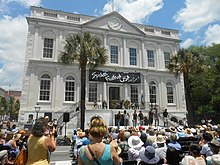
Charleston has a
Fire department

The City of Charleston Fire Department consists over 300 full-time firefighters. These firefighters operate out of 21 companies located throughout the city: 16 engine companies, two tower companies, two ladder companies, a heavy rescue company, a HAZ-MAT unit and several special units. Training, Fire Marshall, Operations, and Administration are the divisions of the department.[134] The department operates on a 24/48 schedule and is a Class 1 ISO rating.[135] Russell (Rusty) Thomas served as Fire Chief until June 2008, and was succeeded by Chief Thomas Carr in November 2008. The department is presently led by Chief Daniel Curia.
Police department
The
EMS and medical centers
Emergency medical services (EMS) for the city are provided by Charleston County Emergency Medical Services (CCEMS) & Berkeley County Emergency Medical Services (BCEMS). The city is served by the EMS and 911 services of both Charleston and Berkeley counties since the city is part of both counties.
Charleston is the primary medical center for the eastern portion of the state. The city has several major hospitals located in the downtown area:
Coast Guard Station Charleston
Coast Guard Station Charleston responds to search and rescue emergencies, conducts maritime law enforcement activities, and Ports, Waterways, and Coastal Security (PWCS) missions. Personnel from Station Charleston are highly trained professionals, composed of federal law enforcement officers, boat crewmen, and coxswains who are capable of completing a wide range of missions. In 2020, the Coast Guard announced plans to construct a 2,800-acre (11 km2) "superbase" on the former Charleston Naval Shipyard complex to consolidate all its Charleston-area facilities and become the homeport for five Security cutters and additional offshore cutters. Construction began on the Superbase in 2024.[142][143]
Coast Guard Sector Charleston (District 7)
- Coast Guard Eurocopter HH-65 Dolphin, Johns Island
- Coast Guard Helicopter Air Facility, Johns Island, Charleston
- Coast Guard Maritime Law Enforcement Academy
- Coast Guard Reserves, Charleston
- Coast Guard Station Charleston
- USCGC Anvil, 75-foot inland construction tender, Charleston
- National Security Cutter
- National Security Cutter(2024 Delivery)
- National Security Cutter
- National Security Cutter
- National Security Cutter
- USCGC Willow, (WLB-202), Charleston
- USCGC Yellowfin, Marine Protector-class coastal patrol boat, Charleston
Military
- Army Corps of Engineers, Charleston District Headquarters
- Joint Base Charleston (Navy & Air Force)
- U.S. Coast Guard
Crime
The following table shows Charleston's crime rate for six crimes that
| Crime | Charleston (2011) | National Average |
|---|---|---|
| Murder | 11.0 | 4.9 |
| Rape | 30.0 | 24.7 |
| Robbery | 162.0 | 133.4 |
| Assault | 195.0 | 160.5 |
| Burglary | 527.0 | 433.8 |
| Theft | 2,957.0 | 2,434.1 |
| Auto thefts | 270.0 | 222.3 |
| Arson | 6.0 | 4.9 |
Transportation
Airport and rail
The City of Charleston is served by the Charleston International Airport. It is located in the City of North Charleston and is about 12 mi (19 km) northwest of downtown Charleston. It is the busiest passenger airport in South Carolina (IATA: CHS, ICAO: KCHS). The airport shares runways with the adjacent Charleston Air Force Base. Charleston Executive Airport is a smaller airport located in the John's Island section of the city of Charleston and is used by noncommercial aircraft. Both airports are owned and operated by the Charleston County Aviation Authority. As of April 2019, British Airways does seasonal non-stop flights from Charleston to London-Heathrow.
Charleston is served by two daily
Interstates and highways
Major highways
 I-26 (eastern terminus is in Charleston)
I-26 (eastern terminus is in Charleston) I-526
I-526 US 17
US 17 US 52 (eastern terminus is in Charleston)
US 52 (eastern terminus is in Charleston) US 78 (eastern terminus is in Charleston)
US 78 (eastern terminus is in Charleston) SC 7 (Sam Rittenberg Boulevard)
SC 7 (Sam Rittenberg Boulevard) SC 30 (James Island Expressway)
SC 30 (James Island Expressway) SC 61 (St. Andrews Boulevard/Ashley River Road)
SC 61 (St. Andrews Boulevard/Ashley River Road) SC 171 (Old Towne Road/Folly Road)
SC 171 (Old Towne Road/Folly Road) SC 461 (Paul Cantrell Boulevard/Glenn McConnell Parkway)
SC 461 (Paul Cantrell Boulevard/Glenn McConnell Parkway) SC 700 (Maybank Highway)
SC 700 (Maybank Highway)
Arthur Ravenel Jr. Bridge
The
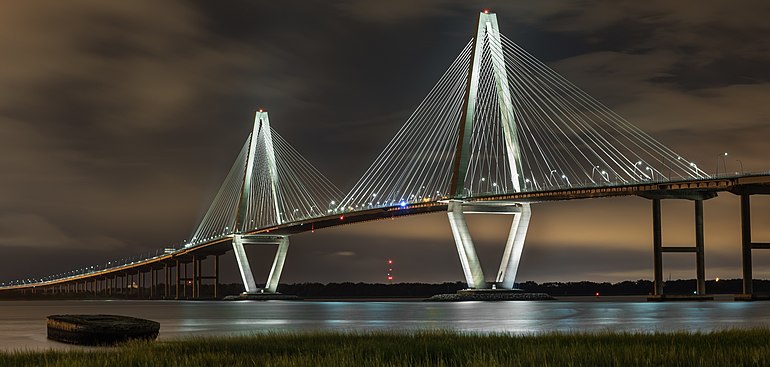
City bus service
The city is also served by a bus system, operated by the Charleston Area Regional Transportation Authority (CARTA). Most of the urban area is served by regional fixed route buses, which are equipped with bike racks as part of the system's Rack and Ride program. CARTA offers connectivity to historic downtown attractions and accommodations with the Downtown Area Shuttle trolley buses, and it offers curbside pickup for disabled passengers with its Tel-A-Ride buses. A bus rapid transit system is in development, called Lowcountry Rapid Transit that will connect Charleston to Summerville through North Charleston.
Rural parts of the city and metropolitan area are served by a different bus system, operated by Berkeley-Charleston-Dorchester Rural Transportation Management Association. The system is also commonly called the TriCounty Link.[146]
Port
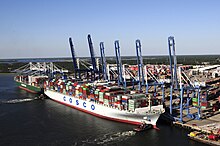
The Port of Charleston, owned and operated by the South Carolina Ports Authority, is one of the largest ports in the United States, ranked seventh in the top 25 by containerized cargo volume in 2018.[125] It consists of six terminals, with the sixth having opened in April 2021.[147] Port activity at the two terminals located in the city of Charleston is one of the city's leading sources of revenue, behind tourism.
Today, the Port of Charleston boasts the deepest water in the southeast region and regularly handles ships too big to transit through the Panama Canal. A harbor-deepening project was completed,[148] which makes the Port of Charleston's entrance channel a depth of 54 feet (16 m) and harbor channel 52 feet at mean low tide. With an average high tide of 6 feet (1.8 m), the depth clearances will become 60 feet (18 m) and 58 feet, respectively. At 52 feet (16 m), the Port of Charleston is the deepest harbor on the East Coast.[149]
Part of Union Pier Terminal, in the city of Charleston, is a cruise ship passenger terminal which hosted numerous cruise departures annually through 2019. Beginning in May 2019, until cruise operations were interrupted in April 2020, the
With the closure of the Naval Base and the Charleston Naval Shipyard in 1996, Detyens, Inc. signed a long-term lease. With three dry docks, one floating dock, and six piers, Detyens Shipyard, Inc. is one of the largest commercial marine repair facilities on the East Coast. Projects include military, commercial, and cruise ships.
Schools, colleges, and universities

Because most of the city of Charleston is located in Charleston County, it is served by the Charleston County School District. Part of the city, however, is served by the Berkeley County School District in northern portions of the city, such as the Cainhoy Industrial District, Cainhoy Historical District and Daniel Island.
Charleston is also served by a large number of independent schools, including
The
Public institutions of higher education in Charleston include the
Media
Broadcast television
Charleston is the nation's 89th-largest Designated market area (DMA), with 332,770 households and 0.27% of the U.S. TV population.[153] These stations are licensed in Charleston and have significant operations or viewers in the city:[154]
- WCBD-TV (2, NBC, CW+)
- WGWG (4, MeTV)
- WCSC-TV (5, CBS, Bounce TV, Grit)
- WITV (7, PBS)
- WLCN-CD (18, CTN)
- WTAT-TV (24, Fox)
- WAZS-CD (29, Azteca AmericaIndependent)
- WJNI-CD (31, America One Independent)
- WCIV (36, MyNetworkTV, ABC)
Notable people
As a population and wealth center with colleges and cultural outlets, Charleston has produced many notable people in all fields. Among the most notable historical and contemporary figures are:
- Jarrell Brantley (born 1996), basketball player
- Madelyn Cline, Actress in Outer Banks
- Stephen Colbert, comedian and host of The Late Show
- Wesley Donehue, political strategist, Internet consultant, CEO
- Ann Drayton, 18th-century landowner
- Shepard Fairey, graffiti artist
- Robert F. Furchgott, recipient of Nobel Prize in Physiology or Medicine (1998)[155]
- Thomas Elfe, interior designer and cabinetmaker
- Thomas Gibson, actor and star of Criminal Minds
- Angry Grandpa, (Charles Green Jr.) YouTube celebrity
- Fritz Hollings, former US Senator and Governor of South Carolina
- Lauren Hutton, model and actress, starring in American Gigolo and The Gambler (1974)
- Robert Jordan (James Oliver Rigney Jr.), fantasy author, notable for The Wheel of Time series
- John Laurens, American revolutionary lieutenant colonel in the continental army
- Peter Manigault, wealthiest person in British North America in 1770
- Khris Middleton, NBA basketball player for the Milwaukee Bucks, gold medal Olympian
- Hootie & The Blowfish
- Robert Smalls, African American civil war hero, businessman, politician, and civil rights activist
- Denmark Vesey, revolutionary
- Joseph Wragg, a pioneer of the large-scale slave trade
Sister cities
Charleston's
 Doha, Qatar
Doha, Qatar Freetown, Sierra Leone
Freetown, Sierra Leone Panama City, Panama
Panama City, Panama Speightstown, Barbados
Speightstown, Barbados Spoleto, Italy
Spoleto, Italy Flers, France
Flers, France
The relationship with Spoleto began when Pulitzer Prize-winning Italian composer Gian Carlo Menotti selected Charleston as the city to host the American version of Spoleto's annual Festival of Two Worlds. "Looking for a city that would provide the charm of Spoleto, as well as its wealth of theaters, churches, and other performance spaces, they selected Charleston, South Carolina, as the ideal location. The historic city provided a perfect fit: intimate enough that the Festival would captivate the entire city, yet cosmopolitan enough to provide an enthusiastic audience and robust infrastructure."[102]
Sister city relation with Panama City was described as follows:[158]
As you may be aware, the city of Charleston, like the city of Panama City, is a historic port City that shares a proud and prosperous history. Our stories are very similar as reflected by our citizens of European, African, Caribbean, native descent, our cuisine, our architecture, and our mutual modern growth in meritime commerce. As Panama City is enjoying a global surge of interest so is Charleston, being ranked as a top destination for travellers, commerce, technology, education, culture and fashion.
— The Honorable Joseph P. Riley Jr., Mayor, City of Charleston 1974–2016
Charleston is also twinned with Speightstown. The first colonists to settle in the region designed the original parts of Charlestown based on the plans of Barbados's capital city, Bridgetown.[159] Many indigo, tobacco, and cotton planters relocated their slaves and plantation operations from Speightstown to Charleston after the sugarcane industry came to dominate agricultural production in Barbados.[160]
See also
Notes
- ^ The female figure is sometimes glossed as Athena,[2] although the official explanation is that she is a personification of Charleston itself.[3] Similarly, although aedes properly refers to temples and originally referred to the churches depicted on the seal, the official gloss is that it intends the city's "buildings".
- ^ As defined by the Office of Management and Budget, for use by the U.S. Census Bureau for statistical purposes only.
- ^ The Brown Fellowship Society, initially a burial society, operated from 1790 to 1945.
- Virginia, came closest, reaching 40% at times.[42]
- ^ A monument to Vesey as a freedom fighter was long opposed by Charleston's white community but was finally begun in 2010 after a compromise placed it in Hampton Park, out of the historic district and far from the original proposed site in Marion Square.[48]
References
- ^ a b "Why is Charleston Called the Holy City?". Low Country Walking Tours. Archived from the original on August 10, 2020. Retrieved November 28, 2020.
- ^ Trouche, Michael (January 28, 2014), "Enlightening Latin", Charleston Footprints, archived from the original on October 9, 2016, retrieved October 9, 2016
- ^ Schultz, Rebecca, "The Seal of the City of Charleston", Official website, City of Charleston, archived from the original on May 4, 2013, retrieved December 9, 2010
- ^ a b "ArcGIS REST Services Directory". United States Census Bureau. Retrieved October 15, 2022.
- ^ "Census Population API". United States Census Bureau. Retrieved October 15, 2022.
- ^ a b c "QuickFacts: Charleston city, South Carolina". United States Census Bureau. Retrieved May 16, 2024.
- ^ a b c "Metropolitan and Micropolitan Statistical Areas Population Totals: 2020-2023". United States Census Bureau, Population Division. March 14, 2024. Retrieved March 15, 2024.
- ^ "US Board on Geographic Names". United States Geological Survey. October 25, 2007. Archived from the original on March 3, 2018. Retrieved October 1, 2016.
- ^ "Find a County". National Association of Counties. Archived from the original on May 31, 2011. Retrieved June 7, 2011.
- ^ "Population of the 100 Largest Urban Places: 1840". Archived from the original on April 20, 2008.
- ^ Michael Kimmelman, "Charleston Needs That African American Museum. And Now." Archived March 29, 2018, at the Wayback Machine, The New York Times, March 29, 2018; accessed March 29, 2018
- ^ "Charleston, where 40% of all US slaves entered the country, finally apologizes for its role in the slave trade". CNN. June 19, 2018. Archived from the original on December 8, 2019. Retrieved December 8, 2019.
- ^ Lewis, J.D. (2007). "Carolina – The Barbadian Settlers, et.al". www.carolana.com. Archived from the original on July 3, 2007. Retrieved January 6, 2018.
Charles Town and surrounding areas were first settled by folks from Barbados and Bermuda
- ISBN 978-0-19-973041-4. Archived from the originalon May 1, 2018. Retrieved January 6, 2018.
- ^ a b c d EB (1911), p. 944.
- ^ Wilson, Thomas D. The Ashley Cooper Plan: The Founding of Carolina and the Origins of Southern Political Culture. p. 12.
- ISBN 0-300-10193-7
- ^ a b c d e f g h i EB (1878), p. 429.
- ^ "Charleston Time Line". Archived from the original on August 6, 2007. Retrieved July 9, 2007.
- ^ "A Charleston Love Story". Xroads.virginia.edu. October 17, 2000. Archived from the original on November 24, 2015. Retrieved May 30, 2017.
- ^ McCandless, Peter (2006). Edgar, Walter B. (ed.). Malaria. Columbia: University of South Carolina Press. Archived from the original on January 10, 2017. Retrieved October 9, 2016.
- ^ "A Brief History of the Circular Church". Circular Congregational Church. Archived from the original on September 22, 2018. Retrieved November 14, 2018.
- ^ "1713 – Sep 16–17, Hurricane, Charleston and vicinity, South Carolina – 70 – Deadliest American Disasters and Large-Loss-of-Life Events". www.usdeadlyevents.com. September 1713. Archived from the original on November 14, 2018. Retrieved November 14, 2018.
- ^ D. Moore. (1997) "A General History of Blackbeard the Pirate, the Queen Anne's Revenge and the Adventure". In Tributaries, Volume VII, 1997. pp. 31–35. (North Carolina Maritime History Council)
- ^ a b Edgar (1998), p. 61
- ^ "A 'Portion of the People'", Harvard Magazine, Harvard University, archived from the original on January 15, 2007, retrieved August 1, 2006
- ^ ISBN 978-0-393-24548-6. Archivedfrom the original on January 16, 2016. Retrieved October 16, 2015.
- ^ History: Gadsden's Wharf Archived July 22, 2017, at the Wayback Machine, International African American Museum; accessed March 29, 2018
- ^ a b "Settlement, Trade, and Conflicts in Colonial South Carolina", The James Poyas Daybook: An Account of a Charles Town Merchant, 1760–1765, Lowcountry Digital History Initiative, archived from the original on October 9, 2016, retrieved October 7, 2016
- ^ a b "The Great Indian Slave Caper". Common-Place. Vol. III, no. 1. October 2002. Archived from the original on October 9, 2016. Retrieved June 17, 2022.
- ^ Opala, Joseph A. (2016), "South Carolina Rice Plantations" (PDF), The Gullah: Rice, Slavery, and the Sierra Leone-American Connection, New Haven: Yale University Gilder Lehrman Center for the Study of Slavery, Resistance, and Abolition, archived from the original on October 6, 2015, retrieved October 7, 2016
- ^ a b c Edgar (1998), p. 67
- ISBN 978-0-8160-6603-2.
- ISBN 978-0-7178-0605-8.
- ^ Diouf (1998), p. 273.
- ^ Sullivan, Mark, ed. (2015), "Building Boom", Charleston, with Hilton Head and the Lowcountry, 4th ed., New York: Fodor's Travel, p. 59, archived from the original on June 17, 2022, retrieved August 25, 2017
- ^ Collector, Senator Ernest F. Hollings-- (2000). "Dock Street Theatre". lcweb2.loc.gov. Retrieved November 6, 2022.
- ISBN 978-0-89879-772-5.
- ^ Urban, Mark, Fusiliers
- ^ McCandless (2011), p. 89.
- ^ Butler, Nic (August 9, 2019). "The Evolution of Charleston's Name". Charleston Time Machine (Podcast). Charleston County Public Library. Retrieved July 11, 2022.
- ^ a b c d e McInnis (2005), p. 28
- ^ Thompson (2015), p. 48
- ^ Kroger, Larry Black. Slaveowners: Free Black Slave Masters in South Carolina, 1790–1860. University of South Carolina Press, 1995.
- ^ Thompson (2015), p. 49
- ^ Thompson (2015), pp. 49–50
- ^ McInnis (2005), p. 225 ff
- ^ a b "Row over Statue to Bermudian's Slave", Bernews, January 3, 2011, archived from the original on October 9, 2013, retrieved November 10, 2013
- ^ McInnis (2005), p. 29
- ^ Olmsted, Frederick Law, mcJourney in the Seaboard Slave States
- ^ Olmsted,[50] cited in McInnis.[42]
- ^ a b c EB (1878), p. 428.
- from the original on May 6, 2016, retrieved August 25, 2017
- ^ from the original on June 19, 2015, retrieved March 6, 2017
- ^ a b Frazier & al. (2016), p. 70
- ^ a b Freehling, William H. (1990), The Road to Disunion: Secessionists at Bay 1776–1854, Oxford: Oxford University Press, pp. 253–70
- ^ "'Mother Emanuel' A.M.E. Church History", Official website, Charleston: Emanuel African Methodist Episcopal Church, 2016, archived from the original on June 20, 2012, retrieved October 9, 2016
- ISBN 9780307483737
- ISBN 9781479830510
- ^ The American annual register. (1827-1829). New York: G. & C. Carvill, vol. 3-4. p. 593.
- ^ Willoughby, Malcolm F. (1957). The U.S. Coast Guard in World War II. Annapolis, Maryland: United States Naval Institute. p. 4.
- ^ "History Engine: Tools for Collaborative Education and Research | Episodes". Historyengine.richmond.edu. Archived from the original on May 8, 2016. Retrieved May 30, 2017.
- ^ a b Craig L. Symonds, The Civil War at Sea (2009) p. 57
- ^ "H. L. Hunley, Confederate Submarine". History.navy.mil. Archived from the original on October 14, 2007. Retrieved September 17, 2014.
- ^ a b "Jeffrey G. Strickland, Ethnicity And Race In The Urban South: German Immigrants And African-Americans In Charleston, South Carolina During Reconstruction, 2003, p. 11, Electronic Theses, Treatises and Dissertations. Paper 1541". Archived from the original on October 28, 2014.
- ^ E. Horace Fitchett, "The Traditions of the Free Negro in Charleston, South Carolina", Journal of Negro History, XXV (April 1940), p. 139
- ^ Thomas Holt, Black Over White: Negro Political Leadership in South Carolina During Reconstruction Archived January 16, 2016, at the Wayback Machine, University of Illinois Press, 1979, p.43
- ^ a b c d Melinda Meeks Hennessy, "Racial Violence During Reconstruction: The 1876 Riots in Charleston and Cainhoy", South Carolina Historical Magazine, Vol. 86, No. 2, (April 1985), 104–106 (subscription required) Archived September 28, 2018, at the Wayback Machine
- ^ Reconstruction as Armed Insurgency: Cainhoy Archived November 6, 2014, at the Wayback Machine, South Carolina during Reconstruction, 2010–2012, accessed October 27, 2014
- ^ Doyle W. Boggs, "Charleston Politics, 1900–1930: An Overview," Proceedings of the South Carolina Historical Association 49 (1979) 1–13.
- ^ Simons, Albert; Lapham, Samuel VI (1927), Charleston, S.C., The Octagon Library of Early American Architecture, Vol. I, Press of the American Institute of Architects.
- ^ Horton, Tom (2014), "Touring Charleston Back in 1912", History's Lost Moments, Vol. V, Trafford, p. 182
- ^ "Century V City of Charleston Population 2010 Estimates" (PDF). Archived from the original (PDF) on July 21, 2011.
- ^ "Search Results for "Naval Base History" – City of North Charleston, SC". Archived from the original on September 5, 2018. Retrieved September 4, 2018.
- ^ a b David Slade, "RACIAL SHIFT: Charleston peninsula's makeup reverses in 30 years, with blacks leaving for suburbs, area becoming two-thirds white" Archived May 16, 2017, at the Wayback Machine, The Post and Courier, March 28, 2011; accessed November 10, 2016
- ^ Bever, Lindsey; Costa, Robert (June 17, 2015). "9 dead in shooting at historic Charleston African American church. Police chief calls it 'hate crime.'". The Washington Post. Archived from the original on February 26, 2017. Retrieved June 18, 2015.
- ^ Johnson, M. Alex (June 17, 2015). "'This Was a Hate Crime': Nine People Killed at Historic South Carolina Church". NBC News. Archived from the original on November 7, 2017. Retrieved June 18, 2015.
- ^ Gomez, Melissa (June 19, 2018). "Charleston Apologizes for City's Role in Slave Trade". The New York Times. Archived from the original on December 21, 2018. Retrieved December 21, 2018.
- ^ EB (1911), p. 943.
- ^ a b c d e "NowData - NOAA Online Weather Data". National Oceanic and Atmospheric Administration. Retrieved May 5, 2021.
- ^ a b "WMO Climate Normals for CHARLESTON/MUNICIPAL, SC 1961–1990". National Oceanic and Atmospheric Administration. Retrieved May 5, 2021.
- ^ a b Mean monthly maxima and minima (i.e. the expected highest and lowest temperature readings at any point during the year or given month) calculated based on data at said location from 1991 to 2020.
- ^ "Summary of Monthly Normals 1991–2020". National Oceanic and Atmospheric Administration. Retrieved May 5, 2021.
- ^ "Historical UV Index Data - Charleston, SC". UV Index Today. Retrieved April 23, 2023.
- ^ "Summary of Monthly Normals 1991–2020". National Oceanic and Atmospheric Administration. Retrieved May 5, 2021.
- ^ "SC ACIS". Applied Climate Information System. Retrieved May 29, 2021.
- ^ "Parishes, Districts, and Counties in Early South Carolina". Charleston County Public Library. June 4, 2021. Retrieved November 6, 2022.
- ^ "U.S. Decennial Census". Census.gov. Archived from the original on April 26, 2015. Retrieved June 5, 2013.
- ^ United States Census Bureau (1909). "Population in the Colonial and Continental Periods" (PDF). A Century of Population Growth. p. 13. Archived (PDF) from the original on August 4, 2021. Retrieved August 17, 2020.
- ^ "Explore Census Data". Archived from the original on June 17, 2022. Retrieved March 6, 2022.
- ^ "Gullah | language | Britannica". www.britannica.com. Retrieved November 6, 2022.
- ^ "Charleston Provincialisms" (1887), Pub. Modern Language Association of America, Vol. iii, Internet Archive and Early Journal Content on JSTOR, accessed November 5, 2014
- ^ Gilbreth, Edward M. (May 25, 2016). "Research says 'Holy City' term not church-based". Post and Courier. Charleston, South Carolina.
- ^ "History of the Huguenot Society". Huguenotsociety.org. Archived from the original on August 30, 2000. Retrieved September 17, 2014.
- ^ Weisman, Jonathan (June 18, 2015). "Killings Add a Painful Chapter to Storied History of Charleston Church". The New York Times. Archived from the original on July 2, 2018. Retrieved June 18, 2015.
- ^ "Kahal Kadosh Beth Elohim". Kkbe.org. Archived from the original on September 24, 2014. Retrieved September 17, 2014.
- ^ "Brith Sholom Beth Israel". Bsbisynagogue.com. Archived from the original on April 12, 2008. Retrieved September 17, 2014.
- ^ Adams, Rhett A. (May 17, 2016). "Freemasonry". South Carolina Encyclopedia. University of South Carolina, Institute for Southern Studies. Archived from the original on November 9, 2019. Retrieved November 9, 2019.
- ^ "Footlight Players". Footlight Players. Retrieved November 6, 2022.
- ^ "Lexus Charleston Fashion Week | The Events". theevents.charlestonfashionweek.com. Retrieved November 6, 2022.
- ^ Levine, Irene S. (December 16, 2021). "The Cuisine of Charleston: A Unique Mix of History And Geography". More Time to Travel. Retrieved November 6, 2022.
- ^ a b [1] Archived March 14, 2012, at the Wayback Machine
- ^ "Events – Historic Charleston Foundation". Historiccharleston.org. Archived from the original on June 10, 2013. Retrieved May 30, 2017.
- ^ "MLK Weekend • Marathon · Half Marathon · 5k · Youth Marathon · Bike Ride • Going the Distance for the Arts". Charleston Marathon. January 14, 2017. Archived from the original on June 20, 2013. Retrieved May 30, 2017.
- ^ "Southeastern Wildlife Exposition 2017". Sewe.com. Archived from the original on September 29, 2015. Retrieved May 30, 2017.
- ^ "Charleston International Film Festival". Charlestoniff.org. May 18, 2017. Archived from the original on November 6, 2014. Retrieved May 30, 2017.
- ^ Lawrence, Stratton. "Charleston Conference to flood downtown with 1,600 bookworms". Charleston City Paper. Archived from the original on January 14, 2018. Retrieved April 29, 2017.
- ISBN 978-0-7385-4350-5. Archivedfrom the original on January 16, 2016. Retrieved October 16, 2015.
- ISBN 978-0-7385-4350-5. Archivedfrom the original on January 16, 2016. Retrieved October 16, 2015.
- ^ "Jenkins Orphanage Band - Charleston, South Carolina". www.sciway.net. Retrieved November 6, 2022.
- ^ "Our History". jenkinsinstitute.org. Retrieved November 6, 2022.
- ISBN 1-57003-598-9
- ^ Hubbert, Julie. "Jenkins Orphanage". Archived from the original on September 29, 2012. Retrieved February 18, 2013.
- ^ ""Porgy and Bess," the first great American opera, premieres on Broadway". HISTORY. Retrieved November 6, 2022.
- ^ Erb, Jane. "Porgy and Bess (1934)". Archived from the original on January 31, 2013. Retrieved February 19, 2013.
- ^ "Charleston SC Music: Full Guide to Symphonies, Bands, Singers, and Musicians". www.sciway.net. Retrieved November 6, 2022.
- ^ "Theatre Charleston". theatrecharleston.com. Archived from the original on September 5, 2015. Retrieved September 4, 2015.
- ^ "Halsey Institute of Contemporary Art". halsey.cofc.edu. Archived from the original on November 24, 2005. Retrieved May 30, 2018.
- ^ "Old Slave Mart Museum". www.oldslavemartmuseum.com/. Archived from the original on June 12, 2016. Retrieved June 24, 2016.
- ^ Jinkins, Shirley (February 23, 1997). "Charleston S.C. has had a long and turbulent history, but a remarkable number of its buildings have survived". The Baltimore Sun. Retrieved May 30, 2012.[permanent dead link]
- ^ "Waterfront Park: Charleston, South Carolina". www.planning.org. Archived from the original on October 12, 2008. Retrieved April 27, 2016.
- ^ "Charleston Hurling Club". Charleston Hurling Club. Archived from the original on April 2, 2015. Retrieved March 30, 2015.
- ^ "RiverDogs renew affiliation with Tampa Bay Rays". charlestonbusiness.com. December 11, 2020. Archived from the original on December 12, 2020. Retrieved December 12, 2020.
- ISBN 9780809243266.
- ^ a b "Top 25 Water Ports by Containerized Cargo". USDOT Bureau of Transportation Statistics - Freight Facts and Figures Figure 3-11. October 13, 2020. Archived from the original on October 18, 2020. Retrieved October 13, 2020.
- ^ "Volvo shows off its new car plant in South Carolina". Autoblog. June 20, 2018. Archived from the original on January 25, 2020. Retrieved January 24, 2020.
- ^ Wren, David (January 13, 2020). "Volvo to build Charleston-area battery plant to power SC-made vehicles". Post and Courier. Archived from the original on January 13, 2020. Retrieved January 24, 2020.
- ^ "Automotive Industry in Charleston, SC - Auto Business". www.crda.org. Archived from the original on February 23, 2020. Retrieved January 24, 2020.
- ^ "South Carolina Car and Automotive Manufacturers". www.sciway.net. Archived from the original on February 23, 2020. Retrieved January 24, 2020.
- ^ Swartz, Jon (July 29, 2017). "Silicon Harbor has become a tech landing spot for some weary city dwellers". USA TODAY. Retrieved July 6, 2022.
- ^ "Charleston is Silicon Harbor". Charleston is Known As Silicon Harbor. November 18, 2019. Retrieved July 6, 2022.
- ^ Chau, Lisa (July 15, 2015). "Charleston, South Carolina Outpaces the Nation in Tech Growth". HuffingtonPost.com. Archived from the original on February 2, 2017. Retrieved January 21, 2017.
- ^ "Monthly Indicators" (PDF). Charleston Trident Association of REALTORS. June 2017. p. 2. Archived (PDF) from the original on August 14, 2017. Retrieved July 25, 2017.
- ^ "Investigation examining Charleston firefighters' handling of deadly blaze". Ksla.com. June 19, 2007. Archived from the original on July 17, 2014. Retrieved September 17, 2014.
- ^ "California Power of Attorney | Providing POA Forms for California". powerofattorneycalifornia.net. Archived from the original on March 27, 2012.
- ^ "California Power of Attorney | Providing POA Forms for California". powerofattorneycalifornia.net. Archived from the original on February 7, 2012.
- ^ "Ralph H. Johnson VA Medical Center". Charleston.va.gov. Archived from the original on June 4, 2008. Retrieved May 30, 2017.
- ^ Messmer, Carly. "Charleston Hospital – Roper Hospital – Roper St. Francis – Roper St. Francis". Ropersaintfrancis.com. Archived from the original on July 18, 2006. Retrieved December 21, 2005.
- ^ "Roper St. Francis Healthcare | Bon Secours St. Francis Hospital". Archived from the original on April 20, 2009. Retrieved December 14, 2009.
- ^ [2][dead link]
- ^ RC. "Compassionate Pregnancy & Child Birth Services – East Cooper Medical Center". Archived from the original on February 1, 2009.
- ^ Novelly, Thomas (July 20, 2020). "Coast Guard's North Charleston base and Mount Pleasant JROTC program get federal support". Post & Courier. Charleston, South Carolina. Retrieved August 3, 2022.
- ^ Evans, Clay Bonnyman (April 20, 2020). "Power Port". Hilton Head Monthly. Retrieved August 3, 2022.
- ^ "Morgan Quitno Press". www.morganquitno.com. Retrieved November 6, 2022.
- ^ "The $540 Million Super-Strong, Robust Cable-Stayed Bridge In Charleston | Manufacturing America". March 2, 2015. Archived from the original on November 8, 2020. Retrieved July 31, 2020.
- ^ "TriCounty Link rural bus service with flagstop system serving Berkeley, Charleston and Dorchester counties of South Carolina". Ridetricountylink.com. Archived from the original on November 1, 2014. Retrieved September 17, 2014.
- ^ "Charleston Opens First New U.S. Container Terminal in 12 Years". The Maritime Executive. April 9, 2021. Archived from the original on April 9, 2021. Retrieved April 10, 2021.
- ^ "Harbor Deepening". South Carolina Ports. October 13, 2020. Archived from the original on October 14, 2020. Retrieved October 13, 2020.
- ^ "Charleston has deepest harbor on East Coast at 52 feet". South Carolina Ports. December 5, 2022. Retrieved April 4, 2024.
- ^ "Newer, larger Carnival Sunshine to call Charleston home beginning in 2019". postandcourier.com. December 7, 2017. Archived from the original on October 17, 2020. Retrieved October 13, 2020.
- ^ "Private School Charleston SC – Mason Preparatory School". Masonprep.org. May 24, 2017. Archived from the original on July 27, 2011. Retrieved May 30, 2017.
- ^ "Welcome – American College of the Building Arts in Charleston, SC". Buildingartscollege.us. July 12, 2016. Archived from the original on February 17, 2008. Retrieved May 30, 2017.
- ^ "Charleston drops in TV market pecking order". Archived from the original on September 9, 2010. Retrieved September 8, 2010.
- ^ "Television station listings in Charleston, South Carolina – Total station FCC filings found". Archived from the original on July 15, 2011.
- ^ "Robert F. Furchgott – Facts". Nobelprize.org. Archived from the original on June 12, 2017. Retrieved May 30, 2017.
- ^ "Our Sister Cities". Charleston Sister Cities International. Archived from the original on May 27, 2019. Retrieved January 20, 2021.
- ^ GUÉGAN, Nicolas (May 20, 2022). "Flers. Le jumelage avec Charleston, en Caroline du Sud, officialisé". Ouest-France.fr.
- ^ "Panama City". Charleston Sister Cities International. Archived from the original on May 27, 2019. Retrieved January 20, 2021.
- ^ [3] Archived May 24, 2013, at the Wayback Machine
- ^ "Barbados: South Carolina's Mother Colony". Sciway.net. Archived from the original on October 23, 2014. Retrieved September 17, 2014.
Works cited
- Dallas, William Leist Eneas Sweetland (1878), , in Baynes, T. S. (ed.), Encyclopædia Britannica, vol. 5 (9th ed.), New York: Charles Scribner's Sons, pp. 428–429
- Chisholm, Hugh, ed. (1911), , Encyclopædia Britannica, vol. 5 (11th ed.), Cambridge University Press, pp. 943–945
- Edgar, Walter B. (1998), South Carolina: A History, Columbia: University of South Carolina Press, ISBN 9781570032554
- Frazier, Herb; Bernard Edward Powers Jr.; Wentworth, Marjory (2016), We Are Charleston: Tragedy and Triumph at Mother Emanuel, Nashville: W Publishing, ISBN 9780718041496.
- McInnis, Maurie D. (2005), The Politics of Taste in Antebellum Charleston, Chapel Hill: University of North Carolina Press, ISBN 9781469625997
- Thompson, Michael D. (2015), Working on the Dock of the Bay: Labor and Enterprise in an Antebellum Southern Port, Columbia: University of South Carolina Press, ISBN 9781611174755
Further reading
General
- Borick, Carl P. A Gallant Defense: The Siege of Charleston, 1780. University of South Carolina Press, 2003. 332 pp.
- Bull, Kinloch Jr. The Oligarchs in Colonial and Revolutionary Charleston: Lieutenant Governor William Bull II and His Family. University of South Carolina Press, 1991. 415 pp.
- Clarke, Peter. A Free Church in a Free Society. The Ecclesiology of John England, Bishop of Charleston, 1820–1842, a Nineteenth Century Missionary Bishop in the Southern United States. Charleston, South Carolina: Bagpipe, 1982. 561 pp.
- Coker, P. C., III. Charleston's Maritime Heritage, 1670–1865: An Illustrated History. Charleston, South Carolina: Coker-Craft, 1987. 314 pp.
- Doyle, Don H. New Men, New Cities, New South: Atlanta, Nashville, Charleston, Mobile, 1860–1910. University of North Carolina Press, 1990. 369 pp.
- Fraser, Walter J. Jr. Charleston! Charleston! The History of a Southern City. University of South Carolina, 1990. 542 pp. the standard scholarly history
- Gillespie, Joanna Bowen. The Life and Times of Martha Laurens Ramsay, 1759–1811. University of South Carolina Press, 2001.
- Goloboy, Jennifer L. Charleston and the Emergence of Middle-Class Culture in the Revolutionary Era. Athens, GA; University of Georgia Press, 2016.
- Hagy, James William. This Happy Land: The Jews of Colonial and Antebellum Charleston. University of Alabama Press, 1993.
- Hart, Emma. Building Charleston: Town and Society in the Eighteenth Century British Atlantic World (University of Virginia Press 2010, University of South Carolina Press 2015)
- Jaher, Frederic Cople. The Urban Establishment: Upper Strata in Boston, New York, Charleston, Chicago, and Los Angeles. University of Illinois Press, 1982. 777 pp.
- Pease, William H. and Pease, Jane H. The Web of Progress: Private Values and Public Styles in Boston and Charleston, 1828–1843. Oxford University Press, 1985. 352 pp.
- Pease, Jane H. and Pease, William H. A Family of Women: The Carolina Petigrus in Peace and War. University of North Carolina Press, 1999. 328 pp.
- Pease, Jane H. and Pease, William H. Ladies, Women, and Wenches: Choice and Constraint in Antebellum Charleston and Boston. University of North Carolina Press, 1990. 218 pp.
- Phelps, W. Chris. The Bombardment of Charleston, 1863–1865. Gretna, La.: Pelican, 2002. 175 pp.
- Rosen, Robert N. Confederate Charleston: An Illustrated History of the City and the People during the Civil War. University of South Carolina Press, 1994. 181 pp.
- Spence, E. Lee. Treasures of the Confederate Coast: the "real Rhett Butler" & Other Revelations (Narwhal Press, Charleston/Miami, ©1995) OCLC 32431590
Art, architecture, city planning, literature, science
- Cothran, James R. Gardens of Historic Charleston. University of South Carolina Press, 1995. 177 pp.
- Greene, Harlan. Mr. Skylark: John Bennett and the Charleston Renaissance. University of Georgia Press, 2001. 372 pp.
- Hutchisson, James M. DuBose Heyward: A Charleston Gentleman and the World of Porgy and Bess. University Press of Mississippi, 2000. 225 pp.
- Jacoby, Mary Moore, ed. (1994). The Churches of Charleston and the Lowcountry (hardback). Columbia South Carolina: University of South Carolina Press. ISBN 978-0-87249-888-4.
- McCandless, Peter (2011). Slavery, Disease, and Suffering in the Southern Lowcountry. Cambridge University Press. ISBN 9781139499149.
- O'Brien, Michael and Moltke-Hansen, David, ed. Intellectual Life in Antebellum Charleston. University of Tennessee Press, 1986. 468 pp.
- Poston, Jonathan H. The Buildings of Charleston: A Guide to the City's Architecture. University of South Carolina Press, 1997. 717 pp.
- Severens, Kenneth (1988). Charleston Antebellum Architecture and Civic Destiny (hardback). Knoxville: ISBN 978-0-87049-555-7
- Huger Smith, Alice Ravenel; Huger Smith, Daniel Elliott; Simons, Albert (1917), The Dwelling House of Charleston, South Carolina, Philadelphia: J.B. Lippincott & Co.
- Stephens, Lester D. Science, Race, and Religion in the American South: John Bachman and the Charleston Circle of Naturalists, 1815–1895. University of North Carolina Press, 2000. 338 pp.
- Waddell, Gene (2003). Charleston Architecture, 1670–1860 (hardback). Vol. 2. Charleston: Wyrick & Company. p. 992. ISBN 0-941711-68-4
- Yuhl, Stephanie E. A Golden Haze of Memory: The Making of Historic Charleston. University of North Carolina Press, 2005. 285 pp.
- Zola, Gary Phillip. Isaac Harby of Charleston, 1788–1828: Jewish Reformer and Intellectual. University of Alabama Press, 1994. 284 pp.
- Wilson, Thomas D. The Ashley Cooper Plan: The Founding of Carolina and the Origins of Southern Political Culture. Chapel Hill, NC: University of North Carolina Press, 2016.
Race
- Bellows, Barbara L. Benevolence among Slaveholders: Assisting the Poor in Charleston, 1670–1860. Baton Rouge, LA: Louisiana State University Press, 1993.
- Drago, Edmund L. Initiative, Paternalism, and Race Relations: Charleston's Avery Normal Institute. Athens, GA: University of Georgia Press, 1990.
- Egerton, Douglas R. He Shall Go Out Free: The Lives of Denmark Vesey. Madison House, 1999.
- Greene, Harlan; Hutchins, Harry S. Jr.; and Hutchins, Brian E. Slave Badges and the Slave-Hire System in Charleston, South Carolina, 1783–1865. McFarland, 2004. 194 pp.
- Jenkins, Wilbert L. Seizing the New Day: African Americans in Post-Civil War Charleston. Bloomington, IN: Indiana University Press, 1998. 256 pp.
- Johnson, Michael P. and Roark, James L. No Chariot Let Down: Charleston's Free People of Color on the Eve of the Civil War. Chapel Hill, NC: University of North Carolina Press, 1984.
- Kennedy, Cynthia M. Braided Relations, Entwined Lives: The Women of Charleston's Urban Slave Society. Bloomington, IN: Indiana University Press, 2005.
- Powers, Bernard E. Jr. Black Charlestonians: A Social History, 1822–1885. University of Arkansas Press, 1994.
- Strickland, Jeff. Unequal Freedoms: Ethnicity, Race, and White Supremacy in Civil War-Era Charleston. Gainesville, FL: University Press of Florida, 2015.
- Wilson, Thomas D. The Ashley Cooper Plan: The Founding of Carolina and the Origins of Southern Political Culture. Chapel Hill, NC: University of North Carolina Press, 2016.
External links
- Official website
- Charleston Tourism Guide
 Geographic data related to Charleston, South Carolina at OpenStreetMap
Geographic data related to Charleston, South Carolina at OpenStreetMap


